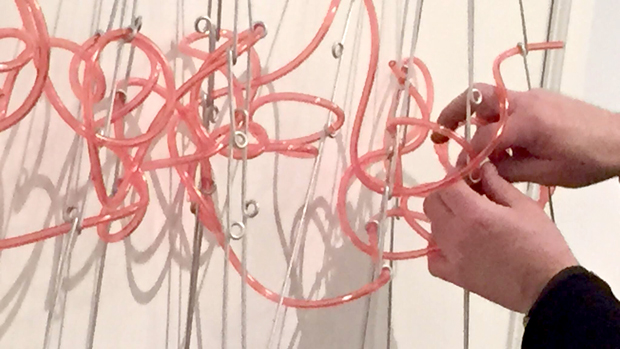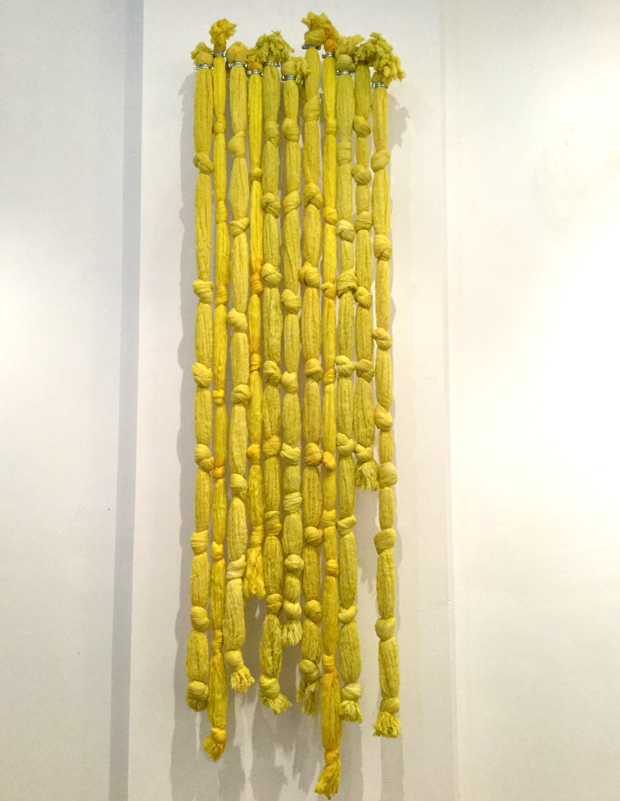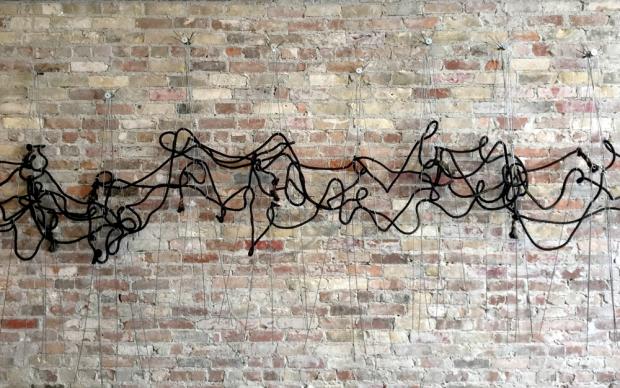Jozef Bajus at Indigo Art Gallery
Jozef Bajus’s abstract sculptural artworks currently on show at the Indigo Art Gallery consist of hanging clusters of straight wire but kinked—like a garden hose—here and there along the way, and tangles of clear plastic tubing or hemp rope threaded through the kink holes, interconnecting the separate wire strands and sometimes separate wire hanging clusters. Or sometimes just tangles or spirals of larger-gauge red or white tubing installed as wall hangings. Or a centerpiece floor sculpture tanglework ball of still larger-gauge darkish-hued tubing, one end of which disappears into a happenstance cutout small hole in the floor. The hole looks like it was there from long ago, and cut out for who knows why. But all as if to say, who knows where this tubing is coming from. Or how long it’s going to keep on coming. How big the tanglework ball is going to get. Or what it is or what it’s doing. Maybe some kind of a trap. Something something could get into and not be able to get out. Like a lobster trap. Or spider trap, maybe. (Spider construction, that is. Not to trap spiders, but whatever other unwary prey. Though other spider species eligible, no doubt.)

And various layered materials, with cutouts so you can see—encounter—the different layers. One work, called Heads, consists of three large portrait photos of the artist—the only non-abstract items among all the artworks—under overlay black paper perforated with mandorla-shaped cutouts. Other works are in fabric in hard to decipher belt-like constructions multiply folded-over—belt width to belt width—and hung in lines of vertical strips. Others are torn paper scraps sutured with copious staples into a kind of fabric or skin. One with a head hole cutout, like a poncho, is called Second Skin. Another work consists of concentric paper cylinders torn so as to expose all the cylinder layers. And rubbings on paper of various knotholes in the gallery old wooden floor—a little like but not like the hole the dark-hued tube disappears into.
Art about layers and holes, as interstices—gaps—between the layers, but also as connectives. The ancient Greek word poros—from which we get the English word pore—pre-Greek it had to mean something like simply a piercing, a hole—by classical times had come to mean a pathway, passageway, and from there—among the tragedians especially—a voyage, a journey. With the distinct connotation of possibility. Aporos—same word with the alpha privative, negating the sense—meant impossible.

About layers and holes and lines, also as connectives (visual positive connective in contrast and complement to the visual negative connective holes). The straight lines—more or less—of the hanging wires, and tangle and spiral lines of plastic tubing small and large, and complicated meandering back and forth rope line interconnecting a dozen or so hanging wire clusters in a line along a brick wall on one side of the gallery. The other centerpiece work in the exhibit, along with the floor sculpture tanglework ball.
The title of the exhibit is “I Walk the Line,” from the Johnny Cash song. In addition to the obvious reference to line elements in many of the works, the Johnny Cash song is about discipline of a sort, in possible further reference to the discipline quality and characteristic of art—discipline inherent in and essential to artmaking—worth noting and underscoring in the case of such free-form and rambunctious sculptural work as this artist’s.
The Jozef Bajus show continues through May 15.
I WALK THE LINE
Indigo Art Gallery
47 Allen St, Buffalo / indigoartbuffalo.com

